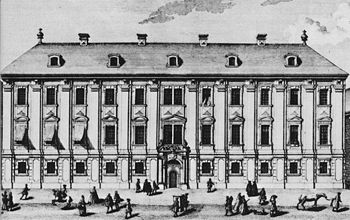
Symphony No. 7 (Haydn)
Encyclopedia

C major
C major is a musical major scale based on C, with pitches C, D, E, F, G, A, and B. Its key signature has no flats/sharps.Its relative minor is A minor, and its parallel minor is C minor....
, Hoboken I/7, is a symphony
Symphony
A symphony is an extended musical composition in Western classical music, scored almost always for orchestra. A symphony usually contains at least one movement or episode composed according to the sonata principle...
by Joseph Haydn
Joseph Haydn
Franz Joseph Haydn , known as Joseph Haydn , was an Austrian composer, one of the most prolific and prominent composers of the Classical period. He is often called the "Father of the Symphony" and "Father of the String Quartet" because of his important contributions to these forms...
, sometimes called "Le midi." The symphony was most likely composed in 1761, together with the other two of the Day Trilogy, No.s 6 and 8.
It is scored for 2 flute
Flute
The flute is a musical instrument of the woodwind family. Unlike woodwind instruments with reeds, a flute is an aerophone or reedless wind instrument that produces its sound from the flow of air across an opening...
s, 2 oboe
Oboe
The oboe is a double reed musical instrument of the woodwind family. In English, prior to 1770, the instrument was called "hautbois" , "hoboy", or "French hoboy". The spelling "oboe" was adopted into English ca...
s, bassoon
Bassoon
The bassoon is a woodwind instrument in the double reed family that typically plays music written in the bass and tenor registers, and occasionally higher. Appearing in its modern form in the 19th century, the bassoon figures prominently in orchestral, concert band and chamber music literature...
, 2 horn
Horn (instrument)
The horn is a brass instrument consisting of about of tubing wrapped into a coil with a flared bell. A musician who plays the horn is called a horn player ....
s, strings and continuo, and exhibits "many concertante features;" indeed, the principal players of each of the string sections "have solos," while the winds are given fairly difficult parts. The work is in four movements:
- Adagio, 4/4 - Allegro, 3/4
- Recitativo: Adagio, 4/4
- MinuetMinuetA minuet, also spelled menuet, is a social dance of French origin for two people, usually in 3/4 time. The word was adapted from Italian minuetto and French menuet, and may have been from French menu meaning slender, small, referring to the very small steps, or from the early 17th-century popular...
to und Trio, 3/4 - Finale: Allegro, 2/4
Unlike the sunrise of Le matin
Symphony No. 6 (Haydn)
The Symphony No. 6 in D major is an early symphony written by Joseph Haydn and the first written after Haydn had joined the Esterházy court. It is the first of three that are characterised by unusual virtuoso writing across the orchestral ensemble...
, the slow introduction to the opening movement here is a ceremonial march.
The slow movement begins with an extended "recitative" in C minor
C minor
C minor is a minor scale based on C, consisting of the pitches C, D, E, F, G, A, and B. The harmonic minor raises the B to B. Changes needed for the melodic and harmonic versions of the scale are written in with naturals and accidentals as necessary.Its key signature consists of three flats...
featuring a solo violin. The Adagio follows in G major
G major
G major is a major scale based on G, with the pitches G, A, B, C, D, E, and F. Its key signature has one sharp, F; in treble-clef key signatures, the sharp-symbol for F is usually placed on the first line from the top, though in some Baroque music it is placed on the first space from the bottom...
with solo violin and solo cello with prominent obbligato flute parts coloring the accompanying orchestration. The movement ends with an extended cadenza
Cadenza
In music, a cadenza is, generically, an improvised or written-out ornamental passage played or sung by a soloist or soloists, usually in a "free" rhythmic style, and often allowing for virtuosic display....
for the solo violin and cello.
Like the previous symphony, the finale contains numerous solo passages for almost all the instruments, but here its intensified even more with solos and tutti
Tutti
Tutti is an Italian word literally meaning all or together and is used as a musical term, for the whole orchestra as opposed to the soloist...
s often exchanging every other bar. The recapitulation is notably accentuated with horn fanfares.

